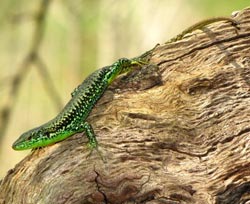Iranian biodiversity was underestimated, several new candidate species found

Darevskia caspica<br>Photo: Naeim Moradi<br>
This high ranked paper recently published in PloS ONE demonstrates to what extent Iranian biodiversity was underestimated and how integrative approaches are crucial to unravel it.
The study was conducted in Zoologisches Forschungsmuseum Alexander Koenig – Leibniz Institute for Animal Biodiversity (ZFMK), Bonn, in close collaboration with Shahid Beheshti University of Iran and Centro de Investigação em Biodiversidade e Recursos Genéticos, Universidade do Porto, Portugal.
Scientists found several candidate species, new to Science, in the northern part of Iran, the area which is covered by Hyrcanian forest and Alborz Mountain range. Given that the area is not so difficult to access, it is really exciting to be discovering such high number of new species.
Our findings also highlight that modern taxonomy requires combining different sources of scientific evidence, namely, genetic markers, ecological models and morphometrics. This has been proven a powerful tool in discovering new aspects of biodiversity.
We suspect that there is still a huge amount of diversity in the area waiting to be discovered. Unfortunately this unique and fragile diversity is now endangered by several threat sources, for instance, overexploiting the forest, losing of the mountainous habitats and, of course, the effects of climate change.
The evidence for a new biodiversity hotspot in the area, surprisingly neglected till present, demands a special conservation attention at both national and international levels, while also recommends further integrative studies to elucidate the hidden biodiversity in other groups from the region.
Contact: Dr. Dennis Rödder, Research Museum Alexander Koenig – Leibniz Institute for Animal Biodiversity, Adenauerallee 160, 53113 Bonn, Germany
Tel: ++228 9122 252
e-mail: d.roedder@zfmk.de
source: http://dx.plos.org/10.1371/journal.pone.0080563
ZFMK: Zoologisches Forschungsmuseum Alexander Koenig – Leibniz-Institute for animal biodiversity is part of the Leibniz Association, a network of 87 scientifically, legally and economically independent research institutes and scientific service facilities. Leibniz Institutes perform strategic- and thematically-oriented research and offer scientific service of national significance while striving to find scientific solutions for major social challenges.
Leibniz Association – German research organisation with 86 research institutes.
Weitere Informationen:
source: http://dx.plos.org/10.1371/journal.pone.0080563
Media Contact
All latest news from the category: Life Sciences and Chemistry
Articles and reports from the Life Sciences and chemistry area deal with applied and basic research into modern biology, chemistry and human medicine.
Valuable information can be found on a range of life sciences fields including bacteriology, biochemistry, bionics, bioinformatics, biophysics, biotechnology, genetics, geobotany, human biology, marine biology, microbiology, molecular biology, cellular biology, zoology, bioinorganic chemistry, microchemistry and environmental chemistry.
Newest articles

Properties of new materials for microchips
… can now be measured well. Reseachers of Delft University of Technology demonstrated measuring performance properties of ultrathin silicon membranes. Making ever smaller and more powerful chips requires new ultrathin…

Floating solar’s potential
… to support sustainable development by addressing climate, water, and energy goals holistically. A new study published this week in Nature Energy raises the potential for floating solar photovoltaics (FPV)…

Skyrmions move at record speeds
… a step towards the computing of the future. An international research team led by scientists from the CNRS1 has discovered that the magnetic nanobubbles2 known as skyrmions can be…





















